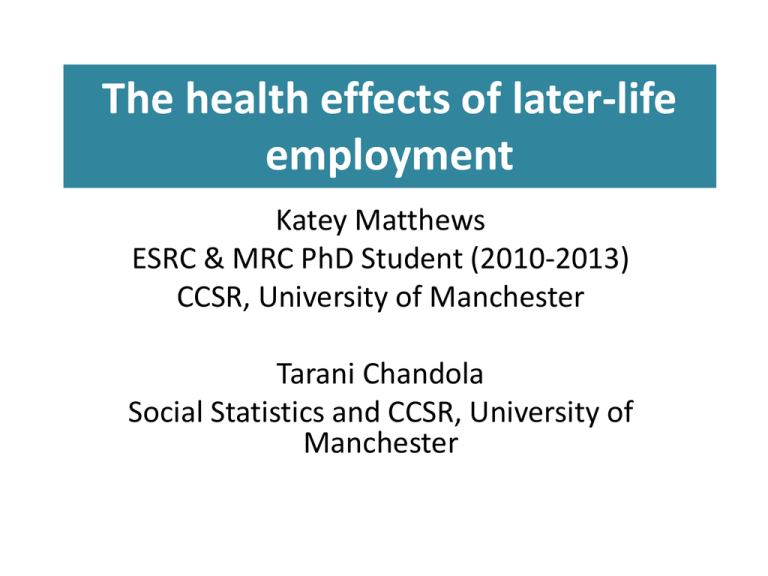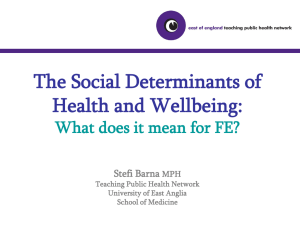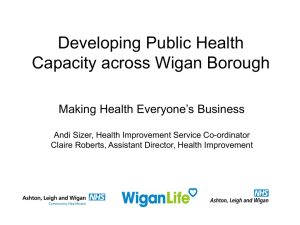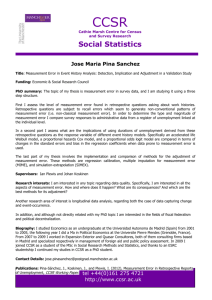The health effects of later-life employment
advertisement

The health effects of later-life employment Katey Matthews ESRC & MRC PhD Student (2010-2013) CCSR, University of Manchester Tarani Chandola Social Statistics and CCSR, University of Manchester The proportion of older people in the workforce is increasing 90% 80% Employment Rate 70% 60% 50% 1992 40% 2001 30% 2010 20% 10% 0% 16-24 25-49 50-64 Labour Force Survey 65+ Who are older workers? • Selected for their good health- “healthy workers effect” • Heterogeneous occupations- consultants and cleaners Most workers aged 65+ are working parttime % of all in employment by employment contract 90% 80% 70% 60% 50% self-employed 40% working part-time in a permanent job 30% 20% 10% 0% 50-54 55-59 60-64 Labour Force Survey 65-69 Workers aged 65+ earn less than those in mid-life £16 £14 £12 £10 £8 average gross hourly wage £6 £4 £2 £0 50-54 55-59 60-64 Labour Force Survey 65-69 Although unemployment among those aged 65+ is low, most are long-term unemployed 60% 50% unemployment rate 40% 30% % of unemployed who are unemployed for 1 year+ 20% 10% 0% 50-54 55-59 60-64 65-69 Labour Force Survey Is working at older ages good for your health? Yes • “Use it or lose” it hypothesis • Financial security and independence • Social networks and relationships No • Work stress • “Unfair” • Less physical activity Prevalence of suboptimum self-rated health in relation to year of retirement: GAZEL men who retired at the statutory age of 55 years High-risk profile=low grade, high demands, and low satisfaction. Low-risk profile=high occupational grade, low physical and psychological demands, and high job satisfaction. The health effects of later-life employment Katey Matthews, PhD Student CCSR, University of Manchester Introduction • What are the health effects of working beyond statutory retirement age in the UK? • Focus on various aspects of wellbeing – – – – Mental wellbeing Cognitive function Self-rated health BMI • Observational study using two datasets: – English Longitudinal Study of Ageing – Whitehall II Cohort Study Background to the topic • Systematic review provides varied findings: – 14 studies show a beneficial effect – 17 studies show a detrimental effect – 5 studies show no effect • Meta-analysis also demonstrates high heterogeneity among results: no real conclusion can be drawn. Meta-analysis: results Depression Pooled effect (d): -0.171 I2 : 98.5% Self-rated health Pooled effect (d): -0.240 I2 : 98.7% Reitzes 1996 Kremer 1985 Gall 1997 Crowley 1986 Butterworth 2006 Gall 1997 Butterworth 2006 Villamil 2006 Dave 2008 Villamil 2006 Van Solinge 2007 Dave 2008 Zucchelli 2007 Wahrendorf 2008 Coursolle 2009 Zucchelli 2007 McMunn 2009 Roberts 2010 McMunn 2009 Combined Combined -2 -1 0 Cohen's d 1 2 -2 -1 0 Cohen's d 1 2 Key problems so far… • Inclusion of non-comparable study participants leads to heterogeneity within results: – Early retirees – Males and females – Differing levels of baseline wellbeing • Subgroup analysis confirms this. • Need to account for these population differences in order to discover whether or not later-life employment does have an effect on wellbeing. Reducing heterogeneity • This study uses only comparable individuals: – Only those over statutory retirement age – Only those who are definitely classed as ‘employed’ or ‘retired’ – Only those who are employed until reaching retirement age. • Propensity score matching used to find the effect of employment beyond retirement age, as opposed to retirement. – “Do differences in wellbeing exist between the groups if all background characteristics are accounted for?” Results, conclusions and next steps • Results of propensity score matching are all non-significant. • When comparing later-life workers and retirees with strictly comparable background characteristics, there is no significant effect on wellbeing. • To what extent do characteristics of employment affect outcomes? • Effort, reward and control are all important considerations.











